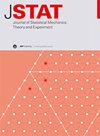Growth, poverty trap and escape
IF 1.9
3区 物理与天体物理
Q2 MECHANICS
Journal of Statistical Mechanics: Theory and Experiment
Pub Date : 2024-08-01
DOI:10.1088/1742-5468/ad6138
引用次数: 0
Abstract
The well-known Solow growth model is the workhorse model of the theory of economic growth, which studies capital accumulation in a model economy as a function of time with capital stock, labour and technology-based production as the basic ingredients. The capital is assumed to be in the form of manufacturing equipment and materials. Two important parameters of the model are: the saving fraction of the output of a production function and the technology efficiency parameter , appearing in the production function. The saved fraction of the output is fully invested in the generation of new capital and the rest is consumed. The capital stock also depreciates as a function of time due to the wearing out of old capital and the increase in the size of the labour population. We propose a stochastic Solow growth model assuming the saving fraction to be a sigmoidal function of the per capita capital . We derive analytically the steady state probability distribution and demonstrate the existence of a poverty trap, of central concern in development economics. In a parameter regime, is bimodal with the twin peaks corresponding to states of poverty and well-being, respectively. The associated potential landscape has two valleys with fluctuation-driven transitions between them. The mean exit times from the valleys are computed and one finds that the escape from a poverty trap is more favourable at higher values of We identify a critical value of below (above) which the state of poverty (well-being) dominates and propose two early signatures of the regime shift occurring at . The economic model, with conceptual foundations in nonlinear dynamics and statistical mechanics, shares universal features with dynamical models from diverse disciplines like ecology and cell biology.增长、贫困陷阱与脱贫
众所周知的索洛增长模型是经济增长理论的主力模型,它以资本存量、劳动力和技术生产为基本要素,研究模型经济中资本积累与时间的函数关系。资本被假定为生产设备和材料。该模型的两个重要参数是:生产函数中产出的储蓄部分和生产函数中的技术效率参数 。产出的储蓄部分全部投资于新资本的生成,其余部分被消耗掉。由于旧资本的损耗和劳动力人口的增加,资本存量也会随着时间的推移而贬值。我们提出了一个随机索洛增长模型,假设储蓄率是人均资本的曲线函数。我们通过分析得出了稳态概率分布,并证明了发展经济学关注的贫困陷阱的存在。在一个参数体系中,双峰分别对应贫困和福利状态,呈双峰分布。相关的潜在景观有两个山谷,山谷之间的过渡是由波动驱动的。我们确定了一个临界值,在该临界值以下(以上),贫困(幸福)状态占主导地位,并提出了在......时发生制度转变的两个早期迹象。经济模型以非线性动力学和统计力学为概念基础,与生态学和细胞生物学等不同学科的动力学模型有着共同的特征。
本文章由计算机程序翻译,如有差异,请以英文原文为准。
求助全文
约1分钟内获得全文
求助全文
来源期刊
CiteScore
4.50
自引率
12.50%
发文量
210
审稿时长
1.0 months
期刊介绍:
JSTAT is targeted to a broad community interested in different aspects of statistical physics, which are roughly defined by the fields represented in the conferences called ''Statistical Physics''. Submissions from experimentalists working on all the topics which have some ''connection to statistical physics are also strongly encouraged.
The journal covers different topics which correspond to the following keyword sections.
1. Quantum statistical physics, condensed matter, integrable systems
Scientific Directors: Eduardo Fradkin and Giuseppe Mussardo
2. Classical statistical mechanics, equilibrium and non-equilibrium
Scientific Directors: David Mukamel, Matteo Marsili and Giuseppe Mussardo
3. Disordered systems, classical and quantum
Scientific Directors: Eduardo Fradkin and Riccardo Zecchina
4. Interdisciplinary statistical mechanics
Scientific Directors: Matteo Marsili and Riccardo Zecchina
5. Biological modelling and information
Scientific Directors: Matteo Marsili, William Bialek and Riccardo Zecchina

 求助内容:
求助内容: 应助结果提醒方式:
应助结果提醒方式:


